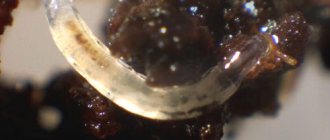Which dogs are at risk for the disease?
Puppies and young dogs are most prone to this disease; the most dangerous period is considered to be from three months to one year. During this period of life, the animal’s teeth are replaced, the immune system becomes weak, and the body is exposed to various kinds of diseases. If the puppy is still being fed by its mother, then it is in little danger of distemper, because antibodies against this terrible disease enter the body with milk, but there are exceptions.
Dog breed has nothing to do with predisposition. Both a mongrel and a pedigree dog can get distemper. The peak incidence is noted in spring and autumn, and it is during these times of the year that every owner should know how to treat distemper in a dog. Providing first aid on time will speed up the recovery process and minimize the possibility of death of the animal.
What is the causative agent of the disease
Paramyxovirus (contained in the body's RNA) is the main and only causative agent of the fatal disease. A characteristic feature of the pathogen is increased resistance to external influences, preservation of all harmful parameters in almost any environmental conditions. The only effective influence that destroys the virus completely is boiling water! The first rule: when caring for a sick animal, it is necessary to regularly and thoroughly disinfect it, cleaning dishes, bowls, toys and other objects surrounding the pet. Sterility and constant disinfection increases the likelihood of getting rid of the disease.
The viral disease is extremely dangerous and has amazing persistence. After the dog has fully recovered, the dangerous elements of the disease carrier remain in the body, manifesting itself in all sorts of secretions - saliva, feces, urine. All these feces pose the highest danger to healthy individuals.
The canine distemper virus is characterized by:
- The ability to reproduce very quickly.
- The strongest pathogenic effect on the dog’s body.
- Lethal effects on various internal organs and systems of the animal.
- Preservation of activity in the secretions of a sick dog.
As soon as the virus enters the dog’s body, it immediately becomes infectious and is a dangerous carrier of infection (with all the ensuing consequences).
Causes of infection
Distemper is caused by a virus that is most dangerous for animals. It penetrates through the respiratory tract or orally.
The main source of infection is interaction with a sick animal; in this case, the dog emits the virus through saliva, urine or feces. If a dog is sick with distemper, then the virus is on all objects that came into contact with it, and these things need to be eliminated; the best way is to burn them. Do not throw away these items; they may cause infection to another animal. Never accept used items from a deceased dog as a gift, as they may carry a dangerous virus. Common causes of animal infection are:
- feeders;
- toys;
- beds;
- carrier bags;
- enclosures that have ever contained infected individuals.
If the dog is a pet and does not interact with other animals, this does not mean that it is safe. The cause of infection can even be ordinary dirt on a person’s shoes, brought home, clothes, or the remains of dirt on a dog’s paws after a walk.
The danger of infection occurs in early spring and late autumn, when above-zero temperatures are not as high as in summer. It is at this time of year that you need to especially protect your pet. So, how to treat distemper in a dog?
Prevention
The occurrence of pathology can be prevented through vaccination. As a rule, puppies are vaccinated against distemper at 2, 6 and 12 months. There are 2 types of serums: with live and killed canine distemper virus. Most often, domestic (Multikan-6.8, Hexakanivac) or foreign drugs are used (Vangard, Hexodog, Kanvak, Pentodog, Dipentovak, Nobivak).
Important! Vaccination does not completely protect against the disease, but it can prevent infection in 99% of cases.
Nonspecific methods of prevention include following the rules of pet hygiene.
If an animal is sick, it is necessary to boil its bowls, toys, bedding and treat the enclosure after distemper - this is the only way to get rid of the virus and eliminate the possibility of infection of animals that appeared in the house after the dog was infected.
Infection period
From the moment the animal comes into contact with a sick individual or with an object carrying the virus, the dog is affected by the disease. But in the first 5-20 days, the dog is only a carrier and distributor, and it is almost impossible to find out that the pet is sick.
The incubation period makes it difficult to diagnose symptoms of distemper in dogs. How to treat your pet during this time? If you see that something is wrong with your dog, but are not sure that it is distemper, then be sure to contact a veterinarian; you cannot self-medicate. The only thing is that you need to provide first aid using folk remedies, which we will talk about later.
When signs of distemper appear in dogs, a veterinarian will tell every dog owner how to treat it. Urgent treatment should be started with the following symptoms:
- A short-term increase in body temperature up to 40 degrees. The fever subsides on its own, and therefore one can note strangeness in the animal’s behavior: the dog is either active or becomes lethargic.
- Appetite decreases, even if the pet loves to eat. The dog even refuses his favorite treats and becomes lethargic.
- The mucous membranes begin to turn red.
- Diarrhea, cough, vomiting always accompany plague.
- The dog begins to be afraid of the light, its eyes water, it hides in the dark corners of the house, and refuses to go for a walk.
- The most recent signs are the inability to get up. The dog becomes weakened, lies down, does not respond to the owner’s voice and does not respond to stimuli. Heavy breathing, protruding tongue and rapid or, on the contrary, weakened heartbeat.
The disease primarily affects the gastrointestinal tract and respiratory system. The virus affects the central nervous system, and the animal experiences convulsions, coordination of movements becomes confused, and paralysis occurs. All the latter symptoms are one hundred percent signs of nervous distemper in dogs. Everyone should know how to treat this disease at home, because the disease cannot be left without treatment; the fatal outcome with plague is 90%. The sooner you start treatment, the greater the chances of rescuing your pet from the other world. Is it possible to treat a dog with distemper with vodka? This question constantly appears on the Internet. Answer: you can, vodka will be an excellent first aid. We will write below how to do this.
Danger to humans
The virus is dangerous to all carnivores and rodents. At risk are dogs, cats, rats, badgers, foxes, ferrets, mongooses, arctic foxes, raccoons and other forest inhabitants. This infection is not transmitted to people, although single cases of infection have been recorded in America and Asia. Scientists believe that strains influence the development of multiple sclerosis; the theory has not been proven.
It is almost impossible to pick up distemper from a pet, but it is better to maintain a distance when in contact: examine only with gloves, thoroughly clean your hands with alcohol, and communicate through a medical mask.
Course and diagnosis
The intensity of the disease depends on the dog’s immunity. There are several forms of development of the disease:
- Lightning development - the dog has no symptoms, but dies within a day.
- Hyperacute course - the dog’s temperature rises sharply, it falls into a coma, and if treatment is not started, the animal will die within 2-3 days.
- Acute form of the disease - the dog exhibits the symptoms described above.
- Chronic distemper - symptoms appear and disappear, in this form the dog is a constant carrier of the virus.
Diagnosis of the disease must be made in a hospital. You will need to be tested to rule out other viral diseases whose symptoms are similar to plague.
Can I switch to a cat?
The causative agents of canine distemper are absolutely safe for cats. This point greatly facilitates the diagnosis of the disease; if both animals live in the same area and suddenly feel unwell, then distemper is immediately ruled out.
Attention! Don't forget about infections that may occur during illness. Be sure to separate dishes, bedding, etc. until the animal is completely restored.
What about the other way around?
The feline distemper virus is safe for dogs. They cannot become infected from each other, since the causative agents of the disease are different. A dog also cannot get sick directly from a person unless for an indirect reason, for example, the virus was brought on outer clothing or shoes.
How to treat distemper in a dog?
It is advisable to send your pet for treatment to a hospital, where professionals will take care of it. If this is not possible, then call a veterinarian at home so that he can make an accurate diagnosis and prescribe treatment.
Since there is no cure for distemper, the fight against the disease is by increasing the animal’s immunity, which will itself fight the virus. The owner requires attention, love, support. It is necessary to build a place for the dog in the dark where it will not be disturbed by light. You also need a special diet. We will tell you in the following content what to feed your pet during illness.
Apartment processing
During treatment, it is necessary not only to create optimal living conditions for the pet, but also to thoroughly clean and disinfect the house, apartment, or enclosure. Treatment of an apartment or house is carried out with means to which the causative agent of canine distemper is sensitive.
For disinfection, use a 2% solution of sodium hydroxide, bleach in combination with 2% active chlorine, Lysol, chloramine, and other chemicals that deactivate the causative agent of this infection.
Replace bowls, bedding, hygiene products, and ammunition with new ones. Dangerous viruses and bacteria may remain on them. Be sure to thoroughly disinfect the enclosure and doghouse.
Specific treatment
Unfortunately, there are no magic injections for plague yet. Scientists are trying to develop them, but so far to no avail. But there are serums that will help minimize the possibility of death - these are liquids with antibodies obtained by processing the blood of animals with high immunity to the disease. The following serums are prescribed:
- "Vitafel";
- "Gixan";
- "Globcan";
- "Avirokan" and the like.
In rare cases, a blood transfusion from an immune dog is used.
The difficulty of such therapy is that the serum must be administered at the very beginning of the disease, and as we have already understood, symptoms can appear both on the first and on the twentieth day after infection. The sooner the serum is administered, the greater the chance of a successful outcome. If you use the serum too late or abandon it altogether, then in rare cases a miracle of healing can occur. When the disease is advanced, all that remains is to rely on the strength of the immune system and the pet’s zeal for life.
The serum should be administered to the animal 1-2 times a day. Since we are talking about the introduction of a foreign protein, you must first inject Diphenhydramine to eliminate allergies.
Answer
In the scientific world, the disease is called Carré's disease. In common parlance - plague. The dogs die from the disaster.
Distemper has been known among dog breeders since ancient times and is also found among wild animals. The most dangerous age for entering the risk zone is cubs from three to twelve months. Adult pets are also at risk. The infection is transmitted from the patient through feces and secretions: nasal, oral and eye. Surprisingly, but true: a person becomes a carrier of the disease. The disease is not dangerous for people; a dog owner has the right to help a sick friend without fear.
Vodka for plague
Treating distemper in a dog with vodka is a proven folk method that has helped save the lives of many four-legged animals. You can give your dog a forty-degree “medicine” in two ways:
- Take a large syringe and remove the needle. Fill it with vodka in the amount of 30-50 grams (depending on the size of the animal), pour it into the mouth, hold the head until the dog completely swallows the drink. Give water to avoid burns to the mucous membranes. This procedure is carried out twice a day. Usually on the second day the dog becomes more active, he develops an appetite, which means that he is on the mend.
- Second method: dilute one raw egg in half a glass of vodka, stir well. Divide the product into two halves, pour one portion into the animal’s mouth, and the second after 12 hours.
Now you know how to treat your dog for distemper at home while you wait for the vet to arrive. Of course, it will not be possible to cure an animal with vodka alone; other therapy must also be used, but this drink will minimize the likelihood of death and help the pet recover faster.
Respiratory manifestations
Can distemper in dogs be treated with antibiotics? Serum and vodka alone will not save the animal. How to treat distemper in a dog at home? The veterinarian will prescribe complex therapy, the regimen of which must be strictly adhered to. In case of respiratory manifestations of the disease (sneezing, coughing, dry nose and cracked earlobes, inflammation of the eyes), it is necessary to contain the reproduction and spread of harmful bacteria. Therefore, it is also necessary to treat distemper in dogs with antibiotics. These medications will only help to cope with the proliferation of bacteria when respiratory symptoms appear, but antibiotics do not treat the plague itself. The doctor will prescribe Ampicillin, Levomycetin, Sulfalen, Sumetrolim, Streptomecin or another antibiotic.
If you do not use it, it will worsen - blindness, loss of smell, pneumonia, bronchitis or pulmonary edema.
Antibacterial drops should be used to clean the eyes and nose. Avoid crusting.
How to treat intestinal distemper in dogs
With this type of distemper, dogs will vomit profusely and have foul, loose, yellow stools. There is often mucus and even blood in the stool. You cannot do without qualified help; you need to urgently call a doctor. The veterinarian will prescribe droppers of plasma-substituting solutions and salts: lactosol, disol, sodium chloride plus 0.5 glucose.
To stop diarrhea and vomiting, so that dehydration does not occur, the following medications are prescribed:
- "Bifikol";
- "Cerucal";
- "Intestopan";
- "Abomin";
- “Smecta” and others that help eliminate toxins and stop diarrhea and vomiting.
There are also folk remedies for normalizing the gastrointestinal tract and removing toxins. Give your dog carrot juice, linden and chamomile decoction. If the dog refuses to drink it voluntarily, then force it in.
With this form of plague, treatment with vodka is unacceptable. The drink will harm already irritated mucous membranes and cause severe dehydration.
Other types of illness
If plague affects the nervous system, the doctor should prescribe the following medications: Mydocalm or analogues - to reduce muscle tone, Pagluferal 2 for epilepsy, for weakness and partial paralysis - one percent Strychnine, in case of severe excitability - diphenhydramine with Aminazine ", benzonal, folic acid, sodium barbital. Intracranial pressure will help reduce 25% magnesium sulfate.
When skin lesions are caused by plague, blisters and crusts appear on the skin, which must be treated with an antiseptic ointment. To prevent your pet from scratching the sores and not licking the ointment, you will need to wear a protective collar. In severe cases, immunostimulants, antibiotics and vitamins are prescribed.
The dog fell ill with distemper. How to treat? Do not give your animal medicine from your first aid kit just in case it helps. All recommendations should only be given by a veterinarian. The article describes the remedies for informational purposes only; the doctor will prescribe the correct dosage and, possibly, other medications.
Diet
We must not forget about special feeding during plague. Food should help boost immunity so that the body can fight harder:
- give more minced meat or finely chopped meat;
- raw egg - twice a week (during illness and during recovery);
- low-fat cottage cheese and kefir;
- broths from meat and vegetables are required; if you cook porridge, then make it liquid, like soup;
- A decoction of motherwort must be poured into drinking water during damage to the nervous system.











